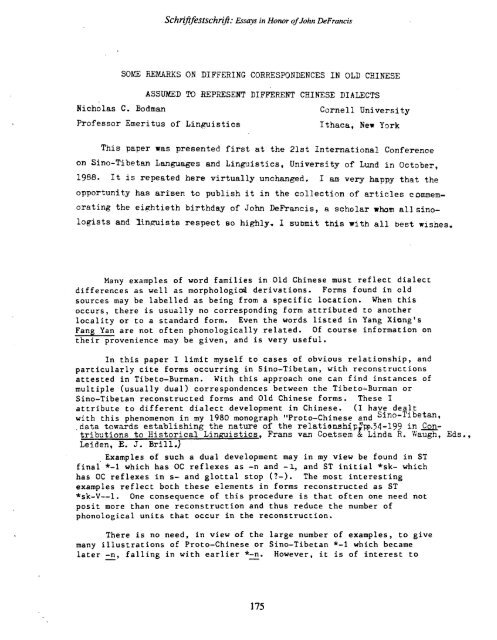Essays on Writing and Language in Honor - Sino-Platonic Papers
Essays on Writing and Language in Honor - Sino-Platonic Papers
Essays on Writing and Language in Honor - Sino-Platonic Papers
Create successful ePaper yourself
Turn your PDF publications into a flip-book with our unique Google optimized e-Paper software.
Schniftfestschrifi: <str<strong>on</strong>g>Essays</str<strong>on</strong>g> <strong>in</strong> H<strong>on</strong>or of John DeFrancis<br />
SOME RENARKS ON DIFFERING CORRESPONDENCES IN OLD CEINESE<br />
ASSUMED TO RSPRESENT DIFFERENT CHINESE DIALECTS<br />
Nicholas C. Bodman Cornell University<br />
Professor Emeritus of L<strong>in</strong>guistics Ithaca, New Ygrk<br />
This paper was presented first at the 21st Internati<strong>on</strong>al C<strong>on</strong>ference<br />
<strong>on</strong> S<strong>in</strong>o-Tibetan <strong>Language</strong>s <strong>and</strong> L<strong>in</strong>guistics, University of Lund <strong>in</strong> October,<br />
1988. It is repeated here virtually unchanged. I am very happy that the<br />
opportunity has arisen to publish it <strong>in</strong> the collecti<strong>on</strong> of articles commem-<br />
orat<strong>in</strong>g the eightieth birthday of John DeFrancis, a scholar whom alls<strong>in</strong>o-<br />
logists <strong>and</strong> l<strong>in</strong>guists respect so highly. I submit tnis with all best wishes.<br />
Many examples of word families <strong>in</strong> Old Ch<strong>in</strong>ese must reflect dialect<br />
differences as well as morphologid derivati<strong>on</strong>s. Forms found <strong>in</strong> old<br />
sources may be labelled as be<strong>in</strong>g from a specific locati<strong>on</strong>. When this<br />
occurs, there is usually no corresp<strong>on</strong>d<strong>in</strong>g form attributed to another<br />
locality or to a st<strong>and</strong>ard form. Even the words listed <strong>in</strong> Yang Xi<strong>on</strong>gls<br />
Fang Yan are not often ph<strong>on</strong>ologically related. Of course <strong>in</strong>formati<strong>on</strong> <strong>on</strong><br />
their provenience may be given, <strong>and</strong> is very useful.<br />
In this paper I limit myself to cases of obvious relati<strong>on</strong>ship, <strong>and</strong><br />
particularly cite forms occurr<strong>in</strong>g <strong>in</strong> S<strong>in</strong>o-Tibetan, with rec<strong>on</strong>structi<strong>on</strong>s<br />
attested <strong>in</strong> Tibeto-Burman. With this apprgach <strong>on</strong>e can f<strong>in</strong>d <strong>in</strong>stances of<br />
multiple (usually dual) corresp<strong>on</strong>dences between the Tibeto-Burman or<br />
S<strong>in</strong>o-Tibetan rec<strong>on</strong>structed forms <strong>and</strong> Old Ch<strong>in</strong>ese forms. These I<br />
attribute to different dialect development <strong>in</strong> Ch<strong>in</strong>ese. (I have dealt<br />
with this phenomen<strong>on</strong> <strong>in</strong> my 1980 m<strong>on</strong>ograph "Proto-Ch<strong>in</strong>ese <strong>and</strong> S<strong>in</strong>o-Tibetan,<br />
.data towards establish<strong>in</strong>g the nature of the relatianshipVpp.!4-199 <strong>in</strong> C<strong>on</strong>-<br />
tributi<strong>on</strong>s to Historical L<strong>in</strong>wistics, Frans van Coettsem & L<strong>in</strong>da R. Viaugh, Eds.,<br />
Leiden, E. J. Brill.)<br />
Examples of such a dual development may <strong>in</strong> my view be found <strong>in</strong> ST<br />
f<strong>in</strong>al* *-1 which has OC reflexes as -n <strong>and</strong> -1, <strong>and</strong> ST <strong>in</strong>itial *sk- which<br />
has OC reflexes <strong>in</strong> s- <strong>and</strong> glottal stop (?-). The most <strong>in</strong>terest<strong>in</strong>g<br />
examples reflect both these elements <strong>in</strong> forms rec<strong>on</strong>structed as ST<br />
*sk-V--1. One c<strong>on</strong>sequence of this procedure is that often <strong>on</strong>e need not<br />
posit more than <strong>on</strong>e rec<strong>on</strong>structi<strong>on</strong> <strong>and</strong> thus reduce the number of<br />
ph<strong>on</strong>ological units that occur <strong>in</strong> the rec<strong>on</strong>structi<strong>on</strong>.<br />
There is no need, <strong>in</strong> view of the large number of examples, to give<br />
many illustrati<strong>on</strong>s of Proto-Ch<strong>in</strong>ese or S<strong>in</strong>o-Tibetan *-1 which became<br />
later -n, fall<strong>in</strong>g <strong>in</strong> with earlier *-no However, it is of <strong>in</strong>terest to<br />
7 -

















